Grapevine cultivation holds secrets to bountiful harvests, and mastering techniques like pruning, defoliation, and thinning is the key. Picture this: a thriving vineyard, a symphony of growth orchestrated by human hands. Pruning, an art that trims away excess, channels the plant’s energy to fruitful clusters.
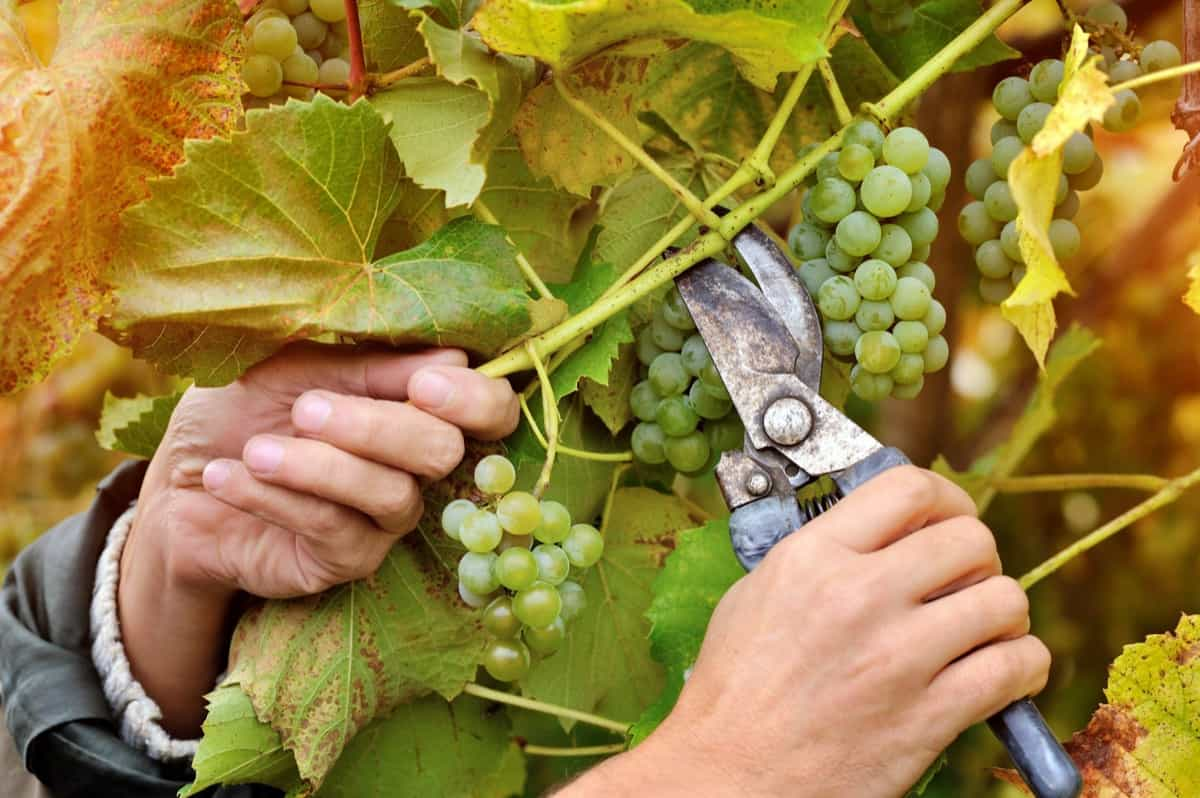
Defoliation, a strategic leaf removal, invites sunlight and airflow, nurturing optimal grape development. Thinning, a delicate task, ensures clusters are manageable, granting each grape space to mature to perfection. Together, these techniques dance in harmony, paving the way for a great yield – nature, and science entwined for a vintage that tells a story of careful tending and rich abundance.
Introduction to Grape Vine Pruning, Defoliation, and Thinning
Few techniques are as powerful when cultivating these fruitful wonders as pruning, defoliation, and thinning. Imagine a vineyard that has been hand-shaped into an artist’s canvas. Pruning, the conductor of growth, splits into two symphonies: Shaping and balancing prunings. Shaping prunings, the architects of vine forms were unveiled in the previous chapter, guiding the vines into their desired structures.
And now, let’s unveil the chapters of Balanced Prunings, a tale of two seasons: Dormant pruning and Summer pruning. Dormant pruning takes center stage during the slumber of winter. This meticulous act influences the next season’s dance between fruits and foliage. Amidst the vine’s hibernation, after leaves have fallen but before buds awaken, farmers orchestrate a grand reduction of wood.
Step-by-step Guide to Pruning Grape Vines
- Identify Dead and Damaged Canes: Examine the vines for discolored, inadequate, or marred canines. These canes should be removed at their base.
- Trim One-Year-Old Growth: Cut back the canes that grew in the previous season to around 4 to 5 inches. This promotes new growth from shorter spurs and prevents vine tangling.
- Thin Out Spurs: Increase air circulation by leaving about 6 inches between the spurs. This minimizes disease risk by improving airflow.
- Remove Undesirable Growth: Trim off shoots wrapping around spurs, canes, or other growths. Also, eliminate suckers that emerge from the grapevine.
- Spring Pruning: If there’s a risk of severe winter weather, delay heavy pruning until early spring. Prune while the vine is dormant to avoid sap oozing and attracting pests.
- Consistent Pruning: Regularly prune vines to prevent messy growth and ensure healthy grape production.
- Arbor Pruning: When growing on an arbor, transplant and prune similarly to trellis or fence-grown vines. Trim newly planted vines back to two or three buds and encourage top growth along the arbor.
In case you missed it: Mastering the Art of Grafting Techniques for Grape Vine
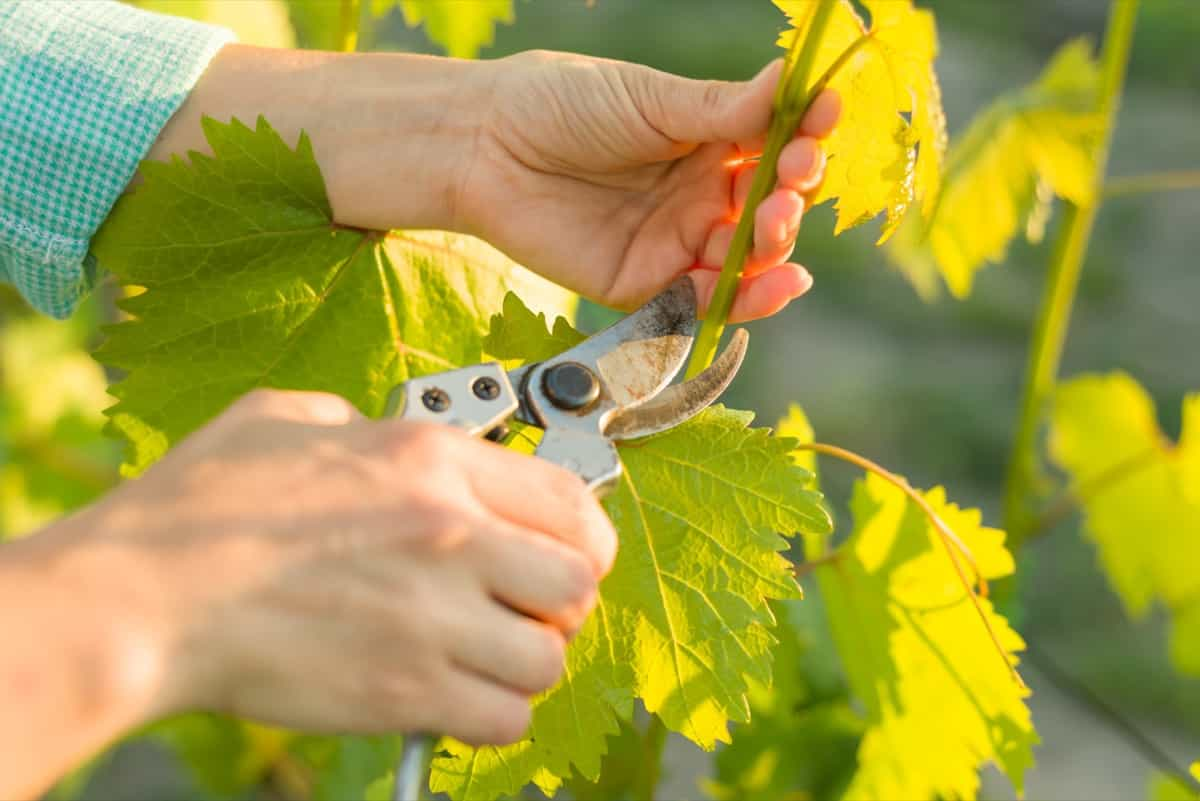
Understanding the Importance of Pruning Grape Vines
- Fruit Concentration: Pruning channels the plant’s energy, leading to fewer but more concentrated grapes – a symphony of flavor.
- Air and Light Dance: Shedding excess foliage, sunlight, and air gracefully pirouette through the vineyard, nurturing healthier growth.
- Disease Defense: Trimming away diseased or infected parts safeguards the vine from spreading ailments like a vigilant guardian.
- Form and Function: Pruning shapes the vine’s structure, ensuring it grows harmoniously and aesthetically.
- Easy Harvest: Careful pruning facilitates easy grape picking, sparing the vintner from unwieldy vines.
- Youthful Renewal: Regular pruning encourages new growth, renewing the vine’s vigor and ensuring perpetual abundance.
- Varietal Character: Pruning allows vintners to manipulate flavors by controlling the number of clusters and grapes.
- Weather Resilience: A well-pruned vine can withstand weather extremes, overcoming adversity.
- Quality Over Quantity: Stripping away excess clusters redirects the plant’s energy towards fewer, superior grapes.
- Longevity and Legacy: Pruning extends the vine’s lifespan, passing down a legacy of well-tended vines to future caretakers.
The Benefits of Defoliation in Grape Vine Management
Stringent yield regulations across the globe and the pursuit of elevated grape quality have reshaped the landscape. We delve into defoliation, an intriguing technique with multifaceted benefits. Vineyards transformed into laboratories, where science marries nature’s artistry. Our study navigates the effects of early defoliation and crop thinning, both manually and mechanically executed, on the enigmatic ‘Tempranillo’ (Vitis vinifera L.) VSP grapevines during the season.
Pre-bloom and veraison. Mechanized marvels were meticulously calibrated based on insights gleaned from prior seasons, a symphony of settings for precision. Intriguingly, the total leaf area remained unchanged, yet yield bowed dramatically (38-40%), rendering a symmetrical dance between leaves and fruit. Clusters bore the impact, their weight, and compactness tamed by the hands of yield regulation.
Berry numbers dwindled, and the lurking specter of Botrytis shrank. An exception surfaced: berry weight, rising amongst mechanically thinned vines, unfazed in the realm of early defoliated plants. A crescendo of compounds unveiled itself: sugars, anthocyanins, and total phenols. And the wine? A symphony of elevated alcohol, color density, and phenolic prowess emerged from mechanically early defoliated vines.
Techniques and Timing for Pruning Grape Vines
- Cane Pruning: Select strong canes and remove the rest, leaving a few buds. It balances growth and yield.
- Spur Pruning: Shorten branches to spurs, each with a few buds. It’s easy and maintains shape.
- Double Guyot: Keep two fruiting canes and two renewal spurs. Offers balance and structure.
- Single Guyot: One cane and one renewal spur. Works well for vigorous varieties.
- Cordon Pruning: Create horizontal branches (cordons) and spur-prune. Ideal for sprawling growth.
- Dormant Season: Best in late winter before buds swell. Plants rest, and cuts heal better.
- Summer Pruning: Remove excess shoots for better airflow and light after fruit sets.
In case you missed it: How to Grow Grapes Organically in Maharashtra: Step-By-Step Cultivation Process and Production Management
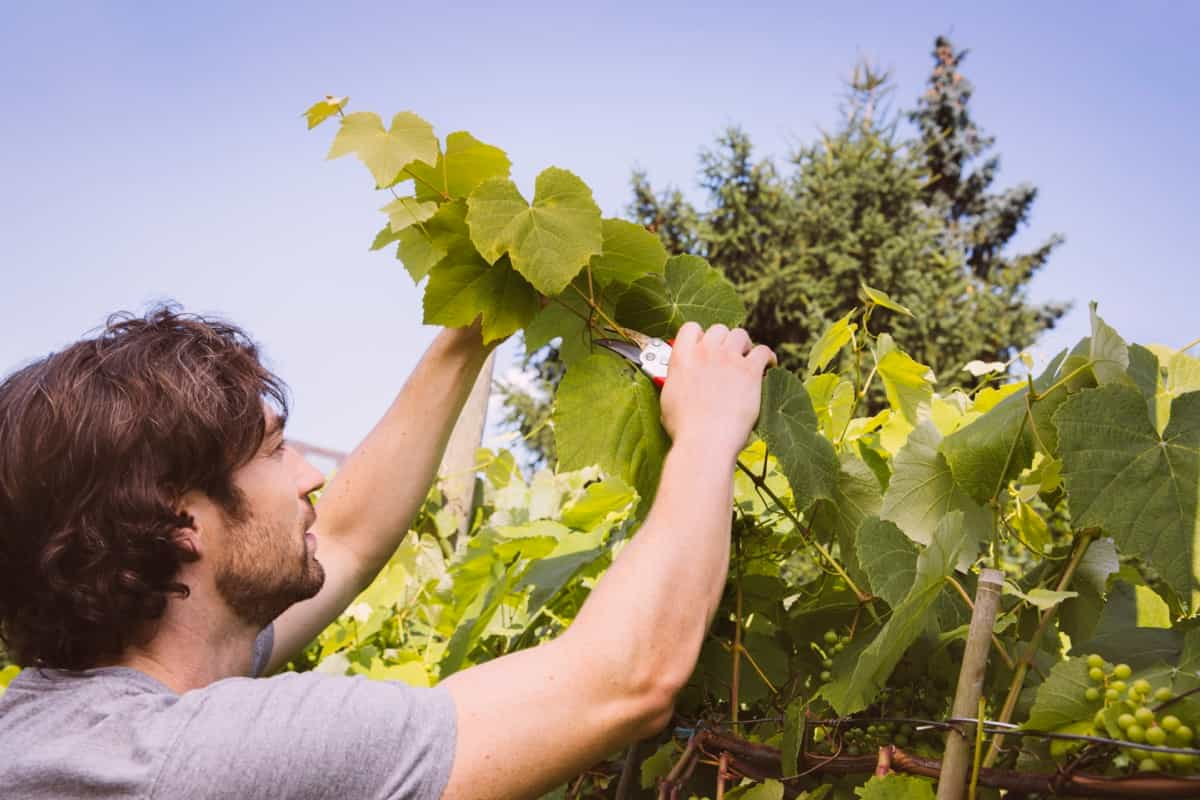
Different Pruning Methods for Different Grape Varieties
Pruning grapevines in Alabama, specifically Muscadine grapevines, is essential for optimal fruit quality and vine productivity. Pruning should occur between December and March to remove dead, diseased, or damaged canes. These canes may show discoloration or blemishes. Pruning should be performed to avoid spreading diseases through the vine.
- Identify and Remove Dead or Damaged Canes: Look for discolored, blemished, or marred canes. Cut these canes at their base and dispose of the wood. Disinfect your pruners between cuts to prevent disease spread.
- Trim One-Year-Old Growth: Cut back the canes that grew in the previous season to a length of 4 to 5 inches. This stimulates new growth from shorter spurs and prevents the tangling of vines.
- Thin Out Spurs: Increase air circulation by leaving about 6 inches between the spurs. Thick vines are more susceptible to diseases due to poor airflow.
- Remove Undesirable Growth: Cut off shoots that wind around spurs, canes, or other shoots. Also, eliminate suckers that grow from the grapevine.
- Spring Pruning: If there’s a risk of severe winter weather, delay heavy pruning until early spring to reduce the danger of cold injury. Prune while the vine is dormant to avoid sap oozing and attracting pests.
- Maintain Consistent Pruning: Regular pruning is crucial to prevent messy vines with fewer or poorer-quality grapes. Neglecting pruning can hinder vine health and fruit production.
- Pruning Grapevines on an Arbor: When growing grapevines on an Arbor, follow similar transplanting and pruning practices as with trellis or fence-grown vines. Prune newly planted vines back to two or three buds and encourage growth along the top of the arbor.
Tools and Equipment Required for Grapevine Pruning
Grapevine pruning is a crucial task that varies depending on the grape variety. Different pruning methods and techniques are used at different stages of the vine growth process. The first stage involves transplanting, reducing shoots, cutting back buds, and removing extra shoots after new growth. The second stage involves first dormant pruning, checking vine height, trimming down healthy plants, and monitoring and training shoots in summer.
The third stage involves pruning established vines with cane pruning, selecting two primary canes close to the vine head, trimming canes to 8-10 buds, and tying to support. The fourth stage involves pruning established vines with a cordon system, choosing canes on either side of the trunk, training them, and shortening fruiting canes to 4 buds.
The fifth stage involves pruning grapes on an arbor, growing one vine per post, pruning lateral canes below, removing old fruiting canes, leaving renewal canes with 2-3 buds, and cutting the remaining canes. The sixth stage involves thinning shoots early, leaving exposed leaves per shoot, and removing leaves before harvest for better air circulation and ripening.
Common Mistakes to Avoid in Grape Vine Pruning
- Over-Pruning: Cutting too much can harm fruit production. Prune only the necessary amount to maintain structure.
- Late Pruning: Prune before new growth starts to prevent sap loss and disease susceptibility.
- Ignoring Disease: Leaving diseased canes can spread infections. Remove them completely.
- Improper Spacing: Crowded growth leads to poor air circulation and disease. Thin out excess growth to enhance airflow.
- Ignoring Different Varieties: Each grape variety has unique pruning needs. Tailor your approach to the specific type.
- Not Training New Growth: Properly guide new growth to avoid a messy vine.
- Skipping Annual Pruning: Regular pruning is essential for healthy, productive vines.
In case you missed it: How this Farmer Making 60 Lakhs from 6 Acres Organic Grape Farm: Organic Grape Cultivation Sucess Story in India
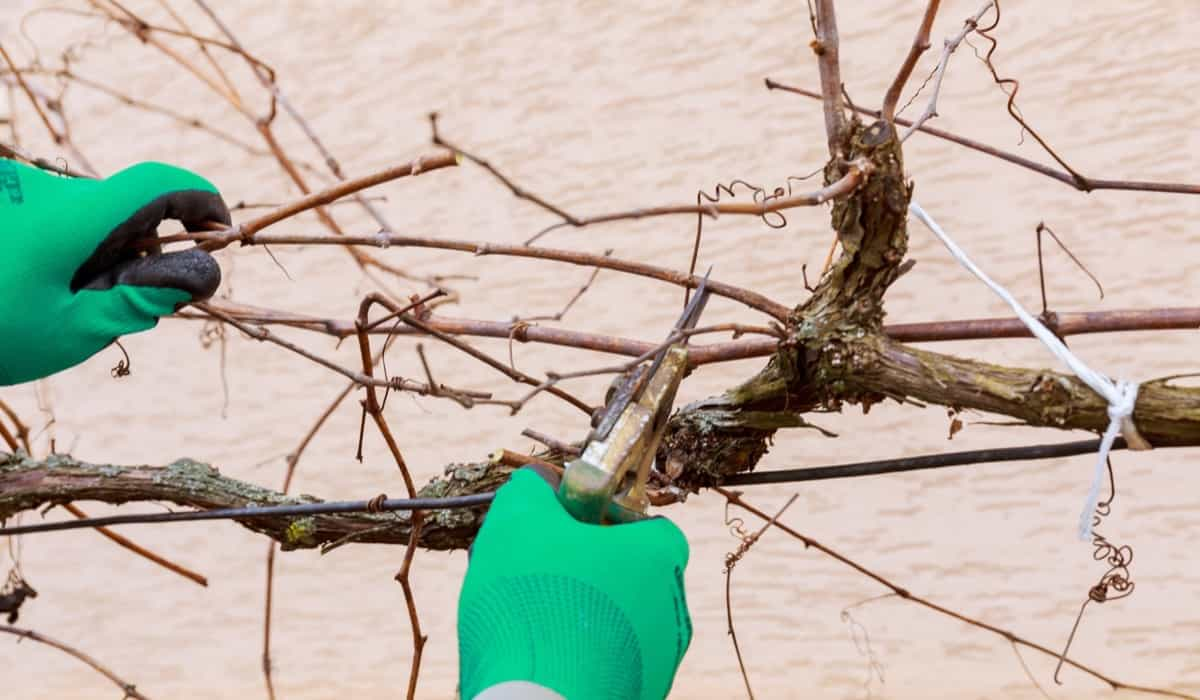
The Role of Defoliation in Grape Vine Health and Yield
Defoliation plays a crucial role in grapevine health and yield. It’s performed manually for better crop aeration and efficient spraying against pests and diseases. Defoliation ensures direct contact between spraying substances and grapes. Red grape varieties benefit from defoliation as it allows sunlight exposure, intensifying the red color. Typically done about 1.5 months before harvest, defoliation varies in timing but is often recommended by agronomists for optimal results.
Defoliation Techniques for Optimal Grape Vine Growth
Defoliation techniques play a vital role in optimal grapevine growth. Suckering involves the early removal of young shoots from undesirable positions to prevent future harm to the plant. Deadheading and pruning cane edges temporarily redirect nutrients to flowering clusters, enhancing fruit quality.
Timing is crucial; early deadheading intensifies bud growth, while mid-fruit maturing deadheading boosts grape quality and eases applications. Defoliation, typically manual, aids crop aeration, allowing direct spraying against pests and diseases. Red grape varieties benefit from defoliation by gaining sunlight exposure for intense red color. These techniques, tailored to plant characteristics, improve yield and grape quality while requiring careful timing and consideration.
The Impact of Thinning on Grape Vine Productivity
Thinning in grape vines refers to removing excess fruit clusters to optimize productivity. This practice ensures that the remaining clusters receive adequate nutrients, sunlight, and airflow, improving grape quality and size. Thinning prevents overcrowding, reduces competition among clusters, and allows the plant to allocate resources more effectively, resulting in higher overall productivity and better-quality grapes.
Thinning Strategies for Managing Grapevine Canopy Density
Thinning strategies are crucial in managing grapevine canopy density for optimal growth. Cluster thinning involves selectively removing excess fruiting clusters, ensuring the remaining ones mature well and maintain high-quality grape production.
This practice is commonly adopted in winemaking vineyards to prioritize quality over quantity, contributing to premium wine production. Another technique is berry thinning, which removes berries from overcrowded clusters, allowing proper growth and preventing fungal infections. Both methods help enhance grape quality, mitigate overcrowding, and ensure healthy grapevine canopy management.
Factors to Consider When Thinning Grape Vines
Grape thinning is influenced by various factors such as variety, canopy density, cluster size, vine vigor, crop load, climate and disease pressure, desired quality, and labor availability. Grape varieties have varying natural cluster densities and growth patterns, which can affect the level of thinning needed.
Overcrowded clusters may require thinning to promote better berry development and prevent fungal issues. Vigorous vines may require more aggressive thinning to balance vegetative growth with fruit production. Climate and disease pressure can also influence the need for thinning to improve air circulation and reduce disease susceptibility. Aligning thinning practices with desired grape quality is crucial, and labor availability can also impact the process.
Best Practices for Pruning, Defoliation, and Thinning in Organic Grape Farming
Pruning: Organic grapevine pruning enhances vine structure and reduces disease susceptibility. Use cleaned, sharp tools to make precise cuts that encourage optimal air circulation and light penetration. Selectively prune away dead, diseased, or crowded shoots, maintaining a balanced canopy. Pruning during the dormant season to minimize stress on the vine and minimize the risk of disease transmission. Regularly inspect vines to identify potential issues and adapt pruning practices accordingly.
In case you missed it: How to Control Pests and Diseases in Grapes: Causes, Symptoms, Chemical, and Biological Management
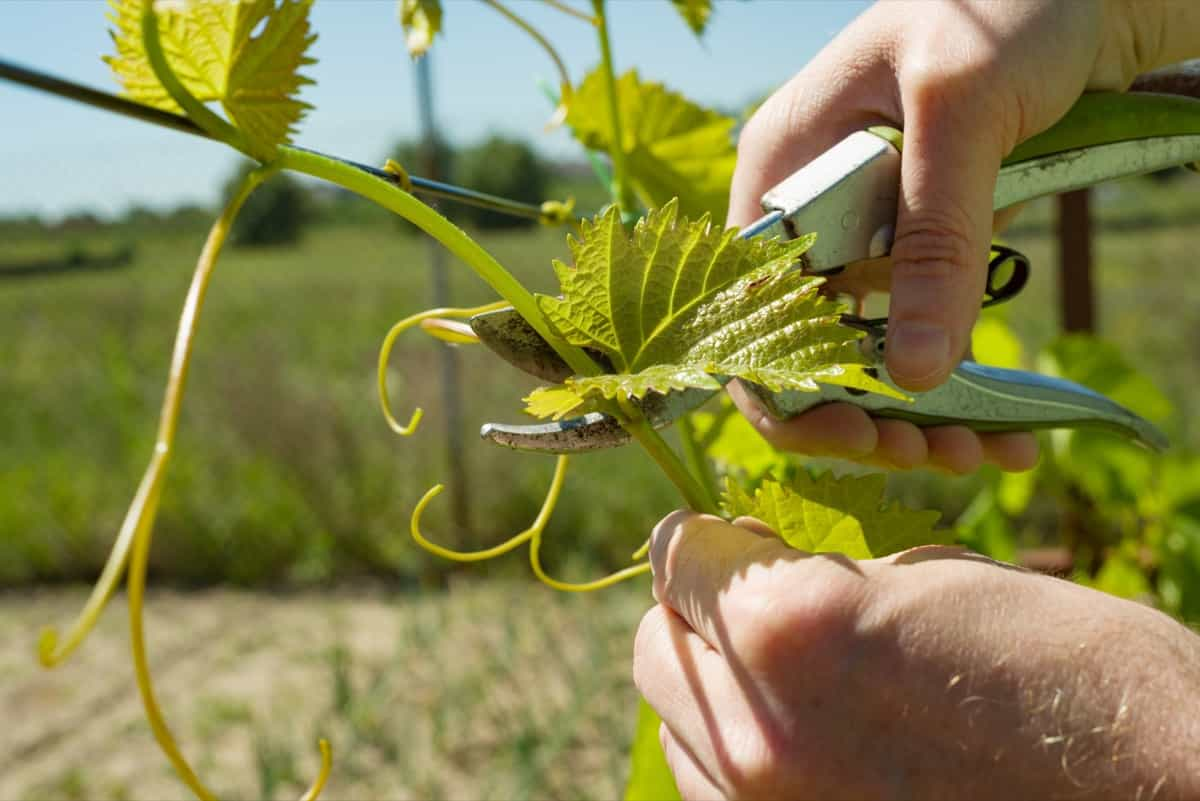
Defoliation: Defoliation aids in disease prevention and quality improvement. Manually remove excess leaves to improve air circulation, minimize humidity, and enhance grape exposure to sunlight. This reduce the risk of disease and fungal infections and improves grape ripening. Defoliate selectively, focusing on the canopy’s interior where airflow is restricted. Timing is crucial; perform defoliation before the onset of disease-friendly conditions.
Thinning: Thinning is essential to regulate grape yield and ensure optimal fruit quality. Apply cluster thinning to control excessive fruit production and reduce competition among clusters. This results in larger, better-ripened grapes. Berry thinning helps prevent deformities and diseases caused by overcrowded clusters. Maintain a balance between canopy density, cluster size, and vine vigor to promote uniform ripening and avoid stress on the plant.
Evaluating the Success of Grape Vine Pruning, Defoliation, and Thinning
Pruning success is determined by balanced canopy structure and disease resistance. Defoliation success relies on improved airflow, reduced disease incidence, and optimal sunlight exposure for grape clusters. Thinning success is measured by cluster size regulation, ensuring uniform ripening and minimizing vine stress. Monitoring grape health, disease prevalence, and fruit quality post-pruning, defoliation, and thinning aids in evaluating the effectiveness of these practices in achieving improved vineyard productivity and grape quality.
In case you missed it: How to Start Grapes Farming in the USA: Production, and A Step-by-Step Growing Guide for Beginners
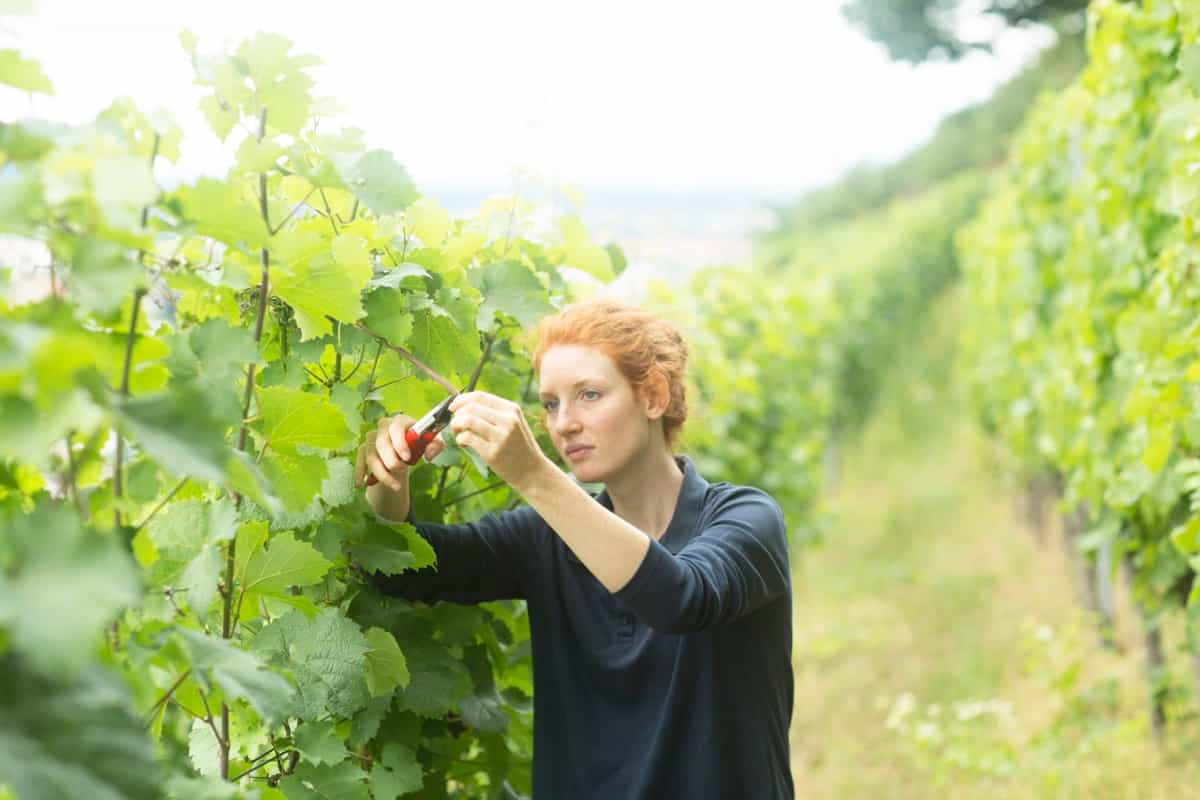
Conclusion
Incorporating meticulous grape vine pruning, defoliation, and thinning practices is pivotal for achieving exceptional yield and grape quality. These essential techniques optimize canopy structure, sunlight exposure, and fruit distribution, ultimately enhancing vineyard productivity and producing superior grape yields.
- Types of Pesticides Used in Agriculture: A Beginner’s Guide
- Economical Aquaculture: A Guide to Low-Budget Fish Farming
- 15 Common Planting Errors That Can Doom Your Fruit Trees
- How to Make Houseplants Bushy: Effective Tips and Ideas
- Innovative Strategies for Boosting Coconut Pollination and Yield
- Pollination Strategies for Maximum Pumpkin Yield
- The Complete Guide to Chicken Fattening: Strategies for Maximum Growth
- Natural Solutions for Tulip Problems: 100% Effective Remedies for Leaf and Bulb-Related Issues
- Revolutionizing Citrus Preservation: Towards a Healthier, Greener Future
- Natural Solutions for Peony Leaf and Flower Problems: 100% Effective Remedies
- Maximizing Profits with Avocado Contract Farming in India: A Comprehensive Guide
- Natural Solutions for Hydrangea Problems: 100% Effective Remedies for Leaf and Flowers
- The Ultimate Guide to Choosing the Perfect Foliage Friend: Bringing Life Indoors
- From Sunlight to Sustainability: 15 Ways to Use Solar Technology in Agriculture
- The Ultimate Guide to Dong Tao Chicken: Exploring from History to Raising
- The Eco-Friendly Makeover: How to Convert Your Unused Swimming Pool into a Fish Pond
- Mastering the Art of Delaware Chicken Farming: Essentials for Healthy Backyard Flocks
- 20 Best Homemade Fertilizers for Money Plant: DIY Recipes and Application Methods
- How to Craft a Comprehensive Free-Range Chicken Farming Business Plan
- Brighten Your Flock: Raising Easter Egger Chickens for Beauty and Bounty
- How to Optimize Your Poultry Egg Farm Business Plan with These Strategies
- Subsidy for Spirulina Cultivation: How Indian Government Schemes Encouraging Spirulina Farmers
- Ultimate Guide to Raising Dominique Chickens: Breeding, Feeding, Egg-Production, and Care
- Mastering the Art of Raising Jersey Giant Chickens: Care, Feeding, and More
- Ultimate Guide to Raising Legbar Chickens: Breeding, Farming Practices, Diet, Egg-Production
- How to Raise Welsummer Chickens: A Comprehensive Guide for Beginners
- How to Protect Indoor Plants in Winter: A Comprehensive Guide
- Ultimate Guide to Grow Bag Gardening: Tips, Tricks, and Planting Ideas for Urban Gardeners
- Guide to Lotus Cultivation: How to Propagate, Plant, Grow, Care, Cost, and Profit
- Agriculture Drone Subsidy Scheme: Government Kisan Subsidy, License, and How to Apply Online
- Ultimate Guide to Raising Araucana Chickens: Breed Profile, Farming Economics, Diet, and Care
- Bringing Hydroponics to Classroom: Importance, Benefits of Learning for School Students
- Ultimate Guide to Raising Polish Chickens: Breed Profile, Farming Economics, Diet, and Care
- Ultimate Guide to Raising Australorp Chickens: Profile, Farming Economics, Egg Production, Diet, and Care
- Silkie Chicken Farming: Raising Practices, Varieties, Egg Production, Diet, and Care
- Sussex Chicken Farming: Raising Practices, Varieties, Egg Production, Diet and Care